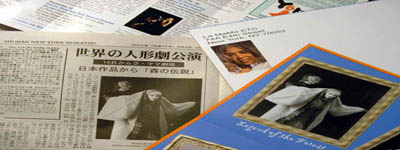

| <Legend of the Forest> THEATRE: La MaMa OPENED: September 23, 2004 CLOSED: September 26, 2004 PERFORMANCES: Thu - Sun at 8pm; Sun at 2:30pm TICKETS: $15 WRITTEN & PERFORMED BY: Noriyuki Sawa DESIGNED BY: Noriyuki Sawa PUPPETS: Noriyuki Sawa Legend of the Forest is a work by master Japanese puppet theatre artist Noriyuki Sawa. This is his New York debut, as part of La MaMa's Puppet Series. In Legend of the Forest, a wounded soldier battles between life and death while lying unconscious in the forest. As he lies on the ground, a woman in white lures the wounded soldier skyward, attempting to leave his wounded body behind in the forest. He contemplates whether to leave his wounded body or return to it, but at last he decides to return into his body and awakens. Miraculously, the deep wound is healed and he starts to walk the forest again as a soldier. Sawa is the author, director, designer, puppetmaker, musical director and actor of the piece. This play will be accompanied by some other small pieces by Sawa. nytheatre.com review Richard Hinojosa E September 23, 2004 The bizarre phenomenon of metamorphosis is a common strategy in nature. It is this sort of transformation that describes the overall style of master puppeteer Noriyuki Sawafs Legend of the Forest. His fusion of the Japanese and Czech approaches to puppet theatre creates a unique creature that slowly emerges, spreads its wings, and flies away. Legend of the Forest is actually a series of short pieces. The first is the showfs namesake, inspired by a Japanese legend of a great warrior who is injured in battle. He escapes his enemies by hiding in the forest. As he lies on the forest floor, a beautiful spirit woman comes to him and draws his spirit out of him. They float around the forest, make love, and generally look like theyfre having a good time. However, when he sees his injured body he decides that hefs not ready to give up his mortal coil and returns to it. The music for the piece was composed and performed by Czech and various other European musicians. It's like chamber music played by stop-action mannequins. I canft say that I really liked the harpsichord but most of the music fit the piece well. Noriyukifs breath of life is absolutely absorbing; his puppets come alive the moment he touches them. The detail in their tiny faces is exquisite, as well as their costumes; but I was not truly engaged until Noriyuki finished this first piece and spoke to us. He is a charming man and I enjoying hearing him introduce and explain the inspiration behind each of the short plays that followed. The first one was inspired by a rainy day in Prague. He performs an enchanting dance with two umbrellas that he has converted into birds. The next piece is about his relationship with a fish that morphs into a butterfly. Almost all of Noriyukifs puppets go through a metamorphosis. They turn inside out to create something completely different or new puppets emerge from the mouths of old ones. I was on the edge of my seat waiting to see what turned into what. One of the last pieces is called "The Nightmare of Lady Macbeth." The transformations in this one are stunning. I wonft give them away here, but it was my favorite part of the show. Noriyuki is so amiable that I felt like I was a member of a small community and he was our villagefs favorite entertainer. As if his shows were something that we eagerly anticipated each month. This performance marked his New York debut. I hope he returns soon to our little village. His extraordinary talent and smiling face will be welcomed here. Last Updated: September 26, 2004 |
|---|